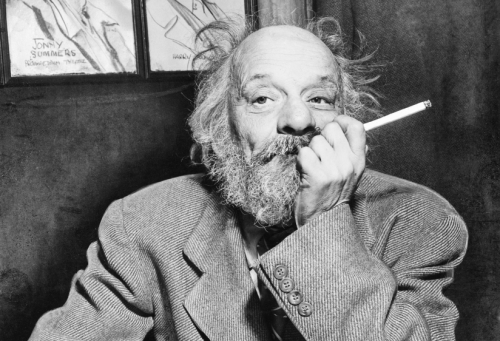
Below is a previously unpublished essay written in 1934 by one of the most legendary figures in American letters: Joe Gould. New Yorker writer Jill Lepore unearthed it while researching her 2016 book Joe Gould’s Teeth. It’s an incredible book. After I spotted the essay in Lepore’s bibliography, I got a copy from Columbia University’s Rare Book & Manuscript Library, where it sat in the Millen Brand Papers for years. “Why I Write” starts as an essay but ends as a fragment. I’m excited to share it with other readers of Lepore and Joseph Mitchell’s work.
First, a little background:
Stanley Tucci made a movie about Joe Gould, but not everyone has seen it. Gould identified as a writer, but he’s best known as the subject of New Yorker writer Joseph Mitchell. Mitchell published two stories about Gould: “Professor Seagull” in 1942 and “Joe Gould’s Secret” in 1964. An educated, heavy drinking bohemian who mixed talent with delusion, Gould lived much of his adulthood on the streets of Greenwich Village in the early 1900s, haunting bars, extracting alms, and telling anyone who would listen about the genre-defining, nine-million-word masterwork he was creating, called “The Oral History of Our Time.” The Oral History was a record of days as Gould heard it. He recorded what people said to him and said all around him. It was meant, in Gould’s words, “to preserve as much detail as I can about the normal life of every day people” because “as a rule, history does not deal with such small fry,” which meant it would qualify as the world’s longest book. Gould told everyone about it, but few had seen it. Whenever people pushed him for pages, Gould dodged or only had brief selections to offer.
Mitchell’s story “Joe Gould’s Secret” outs Gould as a liar whose magnum opus didn’t exist. In telling this secret, Mitchell created his own literary masterpiece, and one of the most well-known and admired pieces of longform journalism in America. In a strange twist, after Mitchell published this story, he never published again in his lifetime.
A modern biography of Mitchell caused a stir by showing that Mitchell invented many details and quotes in his famous reporting, creating magnificent fictive hybrids, not journalism, and that he failed to alert readers to this aspect of their creation. Sensing more to the story of Mitchell’s stories, Jill Lepore went on her own investigation into his reporting techniques and mistakes and asked an important question: Did Gould’s “The Oral History of Our Time” exist or not? Gould certainly seemed to be working on something all those years. Did it get lost or only exist in Gould’s mind? What she found was that Mitchell didn’t do all of his research, and he consciously neglected other areas of inquiry into Gould, failing to contact certain sources and include certain facts. While there was not one cohesive Oral History, Lepore found that Gould did leave notebooks scattered around friends’ houses and various libraries, and he wrote letters to people like E.E. Cummings and John Dos Passos that ended up in collected papers in library archives from Harvard to Yale. Even though he lied about the scale and nature of his masterpiece, Gould did record and even publish things, despite what Mitchell claimed. Because Gould was hypergraphic, Lepore said, “Gould was almost impossibly easy to trace.” This 1934 essay, “Why I Write,” is one of the fragments Gould left laying around. Listed as a chapter of the Oral History, the material has never been published in its entirety. Although it’s short and incomplete, and it’s about the author, not the wider world, it bears the signature Gouldian traits ─ the grand claims, the spiraling train of thought and self-aggrandizement ─ Granted, there’s clearly a reason no one published it. That said, it’s nice to hear him discuss his perception of his work in his own words.
Mitchell’s stories are some of my favorite ever written; they’re some of the few pieces I reread on a regular basis. I believe their construction raise them past the level of reporting to literature, more concerned with themes and capital T truth than the facts of the matter. This isn’t a critique of his work or reportage. But with Gould, Lepore did certain detective work that Mitchell did not. She searched deep in library collections. She found that parts of the Oral History were published early on: a chapter in Exile magazine in 1927, three pages in Pagany in 1931. She photographed all 400-plus pages of Gould’s ten surviving diaries. Gould wrote other essays, such as “My Life” in 1933 and “Why I Am Called Professor Sea Gull” in 1947. Maybe they’re fragments, too, because ultimately, the Oral History existed mostly in Gould’s mind. At a certain point, even Lepore quit digging. I do strongly suggest everyone buy Lepore’s incredible book and to read Mitchell’s collection Up in the Old Hotel.
My deep thanks to Lepore for discovering this material, to the staff at Columbia for sending me a copy, and thanks to Mitchell and Gould for following their instincts. From what I can gather from speaking with professionals, because enough time has passed, and Gould had no living heirs, this work now resides in the public domain.
You can read a PDF of Joe Gould’s “Why I Write” here.



















